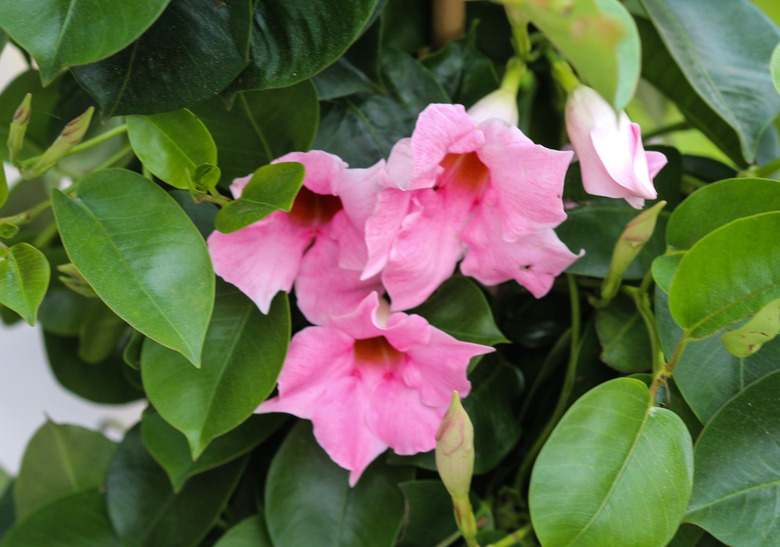How To Care For A Mandevilla Vine
Mandevilla (Mandevilla spp.) is a genus of tropical flowering vines native to Central and South America. Hardy in U.S. Department of Agriculture plant hardiness zones 10 and 11, this warm-climate perennial is also grown as a container annual throughout the United States. With the proper winter care, mandevilla vines can survive and thrive for many years in most climates. Depending on the species and cultivar, mandevilla flowers abundantly in shades of white, yellow, pink or red.
Planting Mandevilla
Plant mandevilla in spring, after the threat of frost has passed. Choose a filtered-shade location with well-drained soil high in organic content. The vine needs some type of structure to vine upon like a trellis, fence or arbor. Spread 1 tablespoon of a high phosphorous fertilizer, such as 10-20-10, over the location prior to planting. Dig a hole the same depth and twice the width of your mandevilla's root ball, and place the plant at the same level it was growing at before. When finished, water thoroughly and continue to water once a week as the vine takes root. Space plants at least 3 feet apart, as mandevilla grows quite large and needs room for growth.
Meeting Water Needs
Mandevilla prefers consistently moist soil while it's actively growing. In warm climates, it may require water three times per week during spring, summer and fall. Container-grown vines dry out quickly, so watch moisture closely. Reduce watering to once per week during winter as the plant enters dormancy. Never allow the soil to become soggy or root rot disease can occur. Water well when you water, then permit the soil to dry out a bit before watering again.
Fertilizing Your Vine
During periods of active growth, fertilize mandevilla once every two weeks (or according to label directions) using a water-soluble 10-20-10 fertilizer at half strength to promote blooms. Always water the soil prior to applying fertilizer, and keep fertilizer off the plant's foliage or fertilizer burn can occur. In winter, dormant mandevilla should not be fertilized. Once new growth begins in spring, start your fertilizer program again.
Winter Care
Within its hardiness zones, mandevilla may die to the ground in tough winters, but come back from the roots in spring. In colder zones, the plant will die unless brought indoors. Garden-grown plants can be transplanted into containers for winters. The soil for a mandevilla needs to be sandy with a fair ratio of organic matter in the soil. Consider a soil mix that is two parts peat moss or soil to one part of sand. If you're growing mandevilla in containers, a commercial potting mix is best.
In order to climb, a mandevilla needs a trellis. The larger the plant the larger the container and trellis should be, at least half as big as the plant. When container grown, simply move mandevilla indoors. Bring mandevilla inside before temperatures drop below 50 degrees Fahrenheit or damage can occur. Provide filtered sunlight and weekly watering for best results indoors. Transplant back to the garden or move containers outside in late spring when temperatures stay above 50 degrees Fahrenheit and all threat of frost has passed.
Pruning and Pests
To make the vine bushier, trim back new shoots to a leaf node during the growing season. Use sanitized pruning shears to snip off the ends. Wipe the blades with rubbing alcohol to keep from spreading disease to the mandevilla. Spider mites and mealy bugs are sometime problematic to the plant. Spray the vine with a strong stream of water to dislodge the insects. When grown in proper conditions and given proper care, mandevilla is relatively pest- and disease-free.
